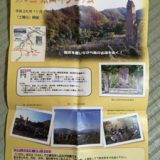只見町ブナセンター 秋版 ポスターイラスト 野焼き
The autumn version of this poster series depicts a scene of Noyaki (open burning of vegetation in the fields), while the mountains and their colorful leaves rise up above and dwarf the row of houses in the background.
If you can say one thing about Noyaki burning, its purpose and season are different depending on what’s needed.
For a small Noyaki burning, rice straw stubble in rice fields or dead trees are burnt during autumn.
Ash from burnt rice straw stubble can be used as compost. If rice straw stubble is left in the field, it will rot and ferment in the soil and will damage the next year’s rice crop.
After harvesting crops such as Junen (wild sesame), any hard, dead and withered bulky branches are chopped up and put onto compost or also incinerated by Noyaki burning.
An example of a larger type of Noyaki is done in the spring after the snow has melted in order to eliminate pests and weeds. In places like Warabi En, larger Noyaki can create an environment where the Warabi will grow thickly.
There are fewer nowadays but Noyaki can be also employed to control weeds and reduce agricultural work in part of the riverbed, mainly on the rice field side.
The people of Tadami have used this everyday wisdom of living with nature for generations and this type of Noyaki field burning still continues today, albeit with permission.
This is not a formal or regular task that takes place with the same conditions every year.
For example, in the case of a relatively wide area, such as burning on the side of a riverbed, residents in each area decide what they will do for spring or autumn work, judging based on grass diseases, insects, the amount of dead trees, the growth of weeds due to rainfall and moisture in the year. When the conditions are met, burning will be added to their seasonal work in the area.
A UNESCO Eco Park or Biosphere Reserve, which Tadami Town was designated in July 2014, promotes an emphasis on the coexistence of nature and human society for the purpose of harmony between ecological conservation and sustainable utilization.
This illustration aims to exactly capture the lives of people living closely with nature.
Large-scale wild burning is often done in spring. When a large amount of smoke is generated from burning fallen leaves or branches in Autumn, the regional fire department needs to be contacted for guidance. During the burning, ordinary household waste, including petroleum products (like plastics) are excluded.
Junen:local Tadami name for Egoma (wild sesame)
Warabi:bracken, a kind of edible wild plant.
Warabi En:a mountain area where tourists are allowed to pick Warabi. En means a garden or a park.
Some illustration information is available in About the Art(English)
More info about the Tadami Beech Centre from the following links:
Buna centre or Japanese Beech tree centre is a local town information centre and museum focusing on research and environmental and cultural conservation work in the surrounding area, located in Tadami town, at the western end of Fukushima prefecture.
Tadami, Fukushima pref.
Located in a heavy snowfall region in the south-west of Fukushima prefecture on the border with Niigata prefecture. Declared「Shizen shuto・Tadami(Capital of Nature・Tadami)in 2007.
Its natural environment and resources together with the life and culture of its residents were judged particularly valuable among the modern world environment,
In 2014 it was designated as a biosphere reserve under the Man and the Biosphere Program. UNESCO’s Japan committee calls them Eco Parks.
 奥会津只見 イラスト美術館
奥会津只見 イラスト美術館 ![イラスト「びゅうコースター 風っこ 会津只見号(トロッコ列車)〜201010〜」 illust [Poster Illustration for Tadami Beech Center (Autumn)]](https://akikanke.sakura.ne.jp/illustration/wp-content/uploads/2020/06/tadami_aki_poster-738x1024.jpg)

